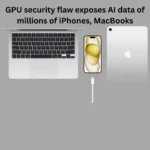Many sensors are included into modern smartphones to improve user experience, give applications more detailed information about the environment they operate in, and extend battery life.
Sensor of Proximity
detects the proximity of an item to the phone. Most frequently used to detect when a person holds a phone close to their ear to turn off the display. In addition to preserving battery life, this stops inadvertent screen touches.
The gyroscope and accelerometer
Mobile phones employ accelerometers to determine the orientation of the device. By monitoring rotation or twist, the gyroscope, or gyro for short, expands on the data provided by the accelerometer.
A gyro, on the other hand, measures the angular rotational velocity, whereas an accelerometer measures linear acceleration of movement. The rate of change is measured by both sensors; they just measure it for distinct purposes.
In practical terms, this implies that without a gyro to provide the necessary information, an accelerometer can only detect a device’s direction of movement; it cannot determine the device’s lateral orientation or tilt during that movement.
An accelerometer can produce a “clean” but slow info output, or it can produce a very “noisy” yet responsive info output. However, a clean and responsive output is obtained when a 3-axis gyro and a 3-axis accelerometer are combined.”
Additionally, accelerometers are utilised to supply’steps’ data for a vendor’s ‘health’ application.
Electronic compass
The digital compass, which gives mobile phones a basic direction with respect to the Earth’s magnetic field, is often based on a sensor known as a magnetometer. Because of this, your phone can automatically rotate your digital maps based on your physical orientation and always know which direction is north.
Barometer
In order to help the GPS chip within the device get a faster lock, the barometer provides real-time altitude data. Furthermore,
The barometer may be used to send data about “floors climbed” to a phone’s “health” app.
With the development of increasingly precise indoor navigation, the barometer can help identify, for example, the floor a user is on at an airport.
Biometrics
Human-associated measurements are recorded and validated by biometric related sensors, which offer heightened security levels. These consist of complete facial recognition, IRIS (eye) scanning, and fingerprint recognition.
Paying for purchases and unlocking phones is made more convenient and safe with the use of biometric sensors.
Furthermore, a user’s pulse rate and SpO2, or the estimation of arterial oxygen saturation, may be obtained via biometric sensors and utilised by vendors in “health” applications.
Virtual and Augmented Reality
Virtual reality applications may be made that are incredibly realistic and responsive because to the strong CPUs and GPUs found in contemporary smartphones, together with the highly precise sensors mentioned above. The sensors make augmented reality apps possible when paired with a smartphone’s camera.


